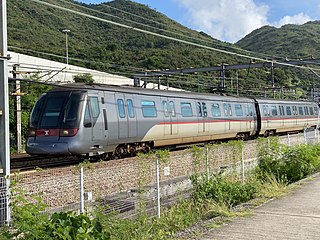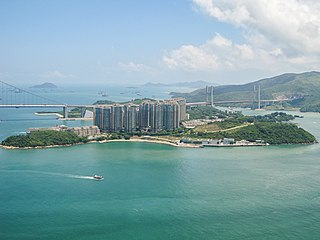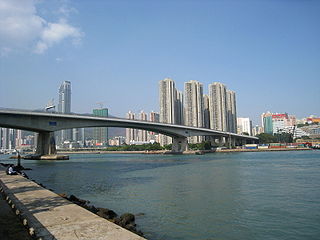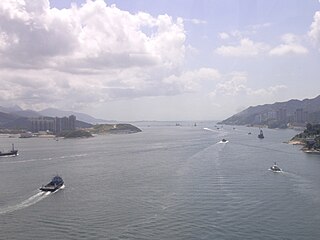
Tsing Ma Bridge is a bridge in Hong Kong. It is the world's 14th-longest span suspension bridge,and was the second longest at time of completion. The bridge was named after the two islands it connects,namely Tsing Yi and Ma Wan. It has two decks and carries both road and rail traffic,which also makes it the largest suspension bridge of this type. The bridge has a main span of 1,377 metres (4,518 ft) and a height of 206 metres (676 ft). The span is the longest of all bridges in the world carrying rail traffic.

Lantau Island is the largest island in Hong Kong,located West of Hong Kong Island and the Kowloon Peninsula,and is part of the New Territories. Administratively,most of Lantau Island is part of the Islands District of Hong Kong. A small northeastern portion of the island is located in the Tsuen Wan District.

The Tung Chung line is one of the ten lines of the MTR system in Hong Kong,linking the town of Tung Chung with central Hong Kong. A part of the Tung Chung line was built along with the Kap Shui Mun Bridge and the Tsing Ma Bridge. The line currently travels through eight stations in 31 minutes along its route. The line is coloured orange on the map.

Ma Wan is an island of Hong Kong,located between Lantau Island and Tsing Yi Island,with an area of 0.97 square kilometres. Administratively,it is part of Tsuen Wan District.

The Lantau Link,formerly known as the Lantau Fixed Crossing,is a roadway in Hong Kong forming part of Route 8 linking Lantau Island to Tsing Yi,from which other roads lead to the urban areas of Kowloon and the rest of the New Territories. Part of the Airport Core Programme centred on the new Hong Kong International Airport on Lantau,the link was officially opened on 27 April 1997,and it opened to traffic on 22 May the same year.

Ting Kau Bridge is a 1,177-metre (3,862 ft) long cable-stayed bridge in Hong Kong that spans from the northwest of Tsing Yi Island and Tuen Mun Road. It is near the Tsing Ma Bridge which also serves as a major connector between the Hong Kong International Airport on Lantau Island and the rest of Hong Kong. It was completed on 5 May 1998. The bridge is toll-free.

Route 8 of Hong Kong is a dual 3-lane carriageway motorway that links Lantau Island,Tsing Yi Island,Cheung Sha Wan in West Kowloon,and Sha Tin in the southeast New Territories of Hong Kong. It is a combination of many sections.

Tsing Yi North Bridge,also called Tsing Tsuen Bridge (青荃橋),connects the Tam Kon Shan Interchange on Tsing Yi Island to the Tsuen Tsing Interchange in Tsuen Wan,spanning the Rambler Channel. Inaugurated on 10 December 1987,the bridge was designed to improve access to Tsing Yi,which at that time was connected to Kwai Chung by only one fixed link,the heavily congested Tsing Yi Bridge.

Ma Wan Channel is a channel between Ma Wan and Tsing Yi islands in Hong Kong. The north end of the channel is Ting Kau where it joins the Rambler Channel. To the west it joins with the Kap Shui Mun channel running to the south of Ma Wan,leading into Urmston Road. To the east,it divides into the Tsing Yi Channel and the Rambler Channel,leading to Tsuen Wan and Kwai Chung. To the south is the Western Working Anchorage of Victoria Harbour.

Stonecutters Bridge is a high level cable-stayed bridge spanning the Rambler Channel in Hong Kong,connecting Nam Wan Kok,Tsing Yi to Stonecutters Island. The bridge deck was completed on 7 April 2009,and opened to traffic on 20 December that year. The bridge was the second-longest cable-stayed span in the world at the time of its completion.

Cheung Tsing Tunnel,also spelled Cheung Ching Tunnel,is a dual tube 3-lane tunnel on Tsing Yi Island,Hong Kong. It is part of Tsing Kwai Highway of Route 3. Its east end connects to Cheung Tsing Bridge and west Cheung Tsing Highway. The tunnel was opened on 22 May 1997 and is the second toll-free tunnel in Hong Kong. Its length is about 1.6 kilometres.

The Airport Core Programme (ACP) was a series of infrastructure projects centred on the new Hong Kong International Airport during the early 1990s. The programme was part of the Port and Airport Development Strategy,commonly known as the Rose Garden Project.

Kap Shui Mun or Throat Gates is the channel between Lantau Island and Ma Wan in Hong Kong. It is part of major sea route along the coast of South China,from Victoria Harbour to the Pearl River. It joins north with Urmston Road. Kap Shui Mun Bridge,part of Route 8,spans the channel.

Urmston Road is a broad body of water between Lantau Island and Tuen Mun in Hong Kong. It forms an inshore passage between the northwest end of Victoria Harbour and the mouth of the Pearl River. At its eastern end it connects to the Western Working Anchorage through the Ma Wan Channel and the narrower Kap Shui Mun channel to the west of Ma Wan.

North Lantau Highway is an expressway forming part of Hong Kong's Route 8,linking Hong Kong International Airport and Lantau Island with the rest of the territory. The road has three lanes in each direction for its entire length with full-width hard shoulders for emergencies and breakdowns. The speed limit is 110 kilometres per hour (68 mph) for most of its length,the highest of any road in Hong Kong.

Tsing Ma Control Area is an area covering Lantau Link and related road networks in Hong Kong,including the Tsing Ma Bridge,Kap Shui Mun Bridge,Ma Wan Viaduct,Cheung Tsing Highway,Cheung Tsing Tunnel,Cheung Tsing Bridge,Ting Kau Bridge,North West Tsing Yi Interchange,Tsing Kwai Highway and North Lantau Highway,but excluding the area of rails managed by MTR.

Ma Wan Viaduct is a viaduct built over Ma Wan,an island in Hong Kong. The viaduct connects the Tsing Ma Bridge and Kap Shui Mun Bridge with an exit to Ma Wan Road,and is part of the Lantau Link and Route 8. It was opened on 22 May 1997 and was built to provide access to the Hong Kong International Airport as part of the Airport Core Programme.
Tsing Chau Tsai Peninsula is the peninsula located at the northeast of Lantau Island,New Territories,Hong Kong,including Yam O,To Kau Wan,Tai Tsing Chau,Tsing Chau Tsai and Penny's Bay. It administratively belongs to Tsuen Wan District,while the remaining areas of Lantau Island belong to Islands District. It is an exclave and it is only connected by Kap Shui Mun Bridge with other part of Tsuen Wan District,like Ma Wan.
Tsing Lung Bridge (青龍大橋) is a proposed suspension bridge in Hong Kong,from North Lantau to Tsing Lung Tau,in the western New Territories,between Tsuen Wan and Tuen Mun,forming part of the Route 10 North Lantau to Yuen Long Highway. The bridge and highway have not been constructed. At the time of its announcement in 2002,it would have been the world's 4th-longest suspension bridge,with a main span of 1,418 metres (4,652 ft) - 41 metres longer than the Tsing Ma Bridge. Detailed planning was then complete and construction was due to commence in 2003 and be open to traffic in 2008.



















